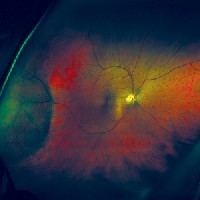Injecting a healthy version of a human gene may successfully treat X-linked juvenile retinoschisis (RS)a formerly untreatable, inheritable eye disease that leads to blindness in malesand eventually other genetic eye diseases that involve the eyes ability to process light, including retinitis pigmentosa, according to a study published in the August issue of Molecular Therapy.
 |
| Retinoschisis can cause total vision loss. Courtesy: Optos Inc. |
RS is most often identified in boys between the ages of 5 and 10 as a result of reported reading problems. It is characterized by cystic spoke-wheel-like maculopathy, peripheral schisis and a negative electroretinogram (ERG).
In a normal eye, a protein called retinoschisin, or RS1, is secreted from retinal cells to hold the layers of the retina together. Those with RS do not have a functional RS1 protein. RS can cause total vision loss later in life due associated complications, such as choroidal sclerosis, vitreous hemorrhage and retinal detachment.
To combat RS, scientists from the University of Florida Genetics Institute, in Gainesville, Fla., injected a normal version of the human RS1 gene into the sub-retinal space of the right eyes of 15-day-old mice that lacked the normal glue-like gene. Their untreated left eyes were used as controls. The extent of RS in the mice was about equal to the state of the disease development in a 10-year-old boy.
On six-month follow-up, results showed:
The treated eyes appeared healthy, while the untreated eyes had cyst formation.
RS1 restored rod- and cone-mediated ERG responses.
Injection of the healthy human gene restored normal retinal distribution of RS1 and corrected retinal structure defects.
The changes seen in the retinal structures appeared long-lasting.
Retinal layers remained connected in treated eyes.
When may a treatment become clinically available? It may take two to five years before we try this in human patients because of the need for safety studies, says William Hauswirth, Ph.D., one of the researchers and professor of molecular genetics and microbiology. But we feel, based on success so far, we will be able to provide formal evidence for safety that will allow us to get treatment into the clinic.
In a normal eye, a protein called retinoschisin, or RS1, is secreted from retinal cells to hold the layers of the retina together. Those with RS do not have a functional RS1 protein. RS can cause total vision loss later in life due associated complications, such as choroidal sclerosis, vitreous hemorrhage and retinal detachment.
To combat RS, scientists from the University of Florida Genetics Institute, in Gainesville, Fla., injected a normal version of the human RS1 gene into the sub-retinal space of the right eyes of 15-day-old mice that lacked the normal glue-like gene. Their untreated left eyes were used as controls. The extent of RS in the mice was about equal to the state of the disease development in a 10-year-old boy.
On six-month follow-up, results showed:
The treated eyes appeared healthy, while the untreated eyes had cyst formation.
RS1 restored rod- and cone-mediated ERG responses.
Injection of the healthy human gene restored normal retinal distribution of RS1 and corrected retinal structure defects.
The changes seen in the retinal structures appeared long-lasting.
Retinal layers remained connected in treated eyes.
When may a treatment become clinically available? It may take two to five years before we try this in human patients because of the need for safety studies, says William Hauswirth, Ph.D., one of the researchers and professor of molecular genetics and microbiology. But we feel, based on success so far, we will be able to provide formal evidence for safety that will allow us to get treatment into the clinic.
Min, SH, Molday, LL, Seeliger, MW, et al. Prolonged recovery of retinal structure/function after gene therapy in an Rs1h-deficient mouse model of X-linked juvenile retinoschisis. Mol Ther 2005 Jul 15;1-8.
Vol. No: 142:9Issue:
9/15/2005

